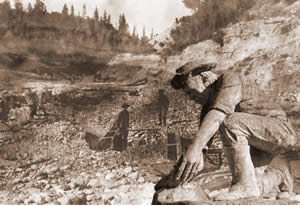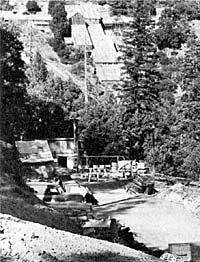Angels Camp
Coloma
Columbia
Dutch Flat
Folsom
Foresthill
Grass Valley
Hammonton
Iowa Hill
Jackson - Plymouth
La Porte
Malakoff
Nevada City
Placerville
Poker Flat
Auburn History
Gold Districts - Alleghany
|
ALLEGHANY Location. Alleghany is in southwestern Sierra County. This district is in a belt of gold mineralization that extends from Goodyear's Bar, south and southeast through Forest, Alleghany, Chip's Flat, and Minnesota. This gold-bearing belt continues south to the Washington district in Nevada County. The Downieville and American Hill districts are to the east, and the Pike district is to the west.
Quartz mining was reported to have begun in the district in 1853 at the German Bar and Irelan mines. Although the quartz mines were moderately productive until the 1870s, drift mining was the principal source of gold then. The rediscovery of the Tightner vein in 1904 by H. F. Johnson (erroneously given as 1907 in many reports) led to the revival of lode mining, which continued until 1965. Alleghany was the only town in California after World War II where gold mining was the principal segment of the economy. After 1960, production from the district, which had been averaging more than $500,000 per year, decreased greatly as more and more mining operations were curtailed. By 1963, the output was less than $100,000 per year. The Sixteen-to-One mine, the largest gold source in the district, curtailed normal operations late in 1962, and the Brush Creek mine, the second largest operation, was shut down in 1964. At the end of 1965 the Sixteen-to-One mine was completely shut down, ending an operation that had lasted more than 60 years. (Editor's note: the Sixteen-to-One mine is again in operation as of 1998.) Intermittent operations have continued at several mines, such as the Kate Hardy, Oriental, El Dorado-Plumbago, and Mugwump mines. Several of the mines received Federal exploration loans. Skin divers are active in the streams of the area. Alleghany was the most famous high-grade gold mining district in California. The value of the total output is unknown, estimated at $50 million. Much of this production was from small but spectacularly rich ore bodies. Geology. The district is underlain by north and northwest-trending beds of metamorphic rocks of the Calaveras Formation (Carboniferous to Permian), serpentine, and greenstone. In the vicinity of Alleghany and Forest this formation has been divided into six units: Blue Canyon Slate, Tightner Formation (chiefly amphibolite and chlorite schist), Kanka Formation (conglomerate, chert, and slate), Relief Quartzite, Cape Horn Slate, and the Delhi Formation (phyllite and slate). These rocks have been invaded by many basic and ultra-basic intrusions; the ultra-basic rocks have been largely serpentinized. Mariposite-bearing rock, locally known as "bluejay," is commonly adjacent to the serpentine. Also present are fine to medium-grained dioritic dikes. The higher ridges are capped by andesite and basalt, which in places overlies auriferous Tertiary channel gravels. Ore deposits. The gold-quartz veins strike in a northerly direction, dip either east or west, and usually range from two to five feet in thickness. They occupy minor reverse faults, and occur in all of the rocks of the Calaveras Formation, and in the greenstone. The largest number of mines are in amphibolites of the Tightner Formation. The most characteristic features of the ore deposits are the extreme richness, erratic distribution and small size of the ore shoots. Th range from small masses of gold and quartz yielding a few hundred dollars to ore bodies that have yielded hundreds of thousands of dollars. One ore body at the Sixteen-to-One mine, which had a pitch length of 40 feet, contained nearly $1 million, while another at the Oriental mine about 14 feet long yielded $734,000. The gold occurs in the native state commonly with arsenopyrite but only small amounts of other sulfides. In a few places pyrite is abundant. The numerous serpentine bodies and associated mariposite rock are structurally important in the localization of the ore bodies. The quartz veins tend to fray or bend near serpentine, and it is in these frayed or bend portions of the veins that the high-grade ore bodies are often found. High-grade ore also is found in vein junctions or in sheared portions of the veins. Channel gravels. A major tributary of the Tertiary Yuba River extended south from Rock Creek through Forest and Alleghany and then southeast through Chip's Flat and Minnesota to Moore's Flat in Nevada County. This is commonly known as the "Great Blue Lead" or Forest channel. It was uniformly rich except where cut by later channels. The largest gold producers were the Ruby, Live Yankee, and Bald Mountain drift mines, where many coarse nuggets were recovered. During the late 1930s a number of fist-sized gold nuggets were recovered from the Ruby mine. These were displayed for many years in the Sierra County exhibit at the California State Fair in Sacramento. Mines. Lode: Brush Creek $4 million+, Dreadnaught $50,000 to $100,000, Docile $100,000 to $200,000, Eclipse $20,000 to $50,000, El Dorado $325,000, German Bar $200,000, Gold Canyon $750,000 to $1 million, Gold Crown, Golden King $250,000, Irelan $350,000 to $500,000, Kate Hardy $700,000, Kenton $1 million to $1.25 million, Mariposa $50,000, Morning Glory $80,000 to $100,000, Mugwump (both lode and placer) $50,000, North Fork (both lode and placer) $125,000, Oriflamme, Ophir, Oriental $2.85 million, Osceola, Plumbago $3.5 million, Rainbow $2.5 million, Rainbow Extension, Red Ledge, Red StarOsceola- $200,000, Rising Sun $58,000, Shannon, Sixteen-to-One $25 million+, South Fork (both lode and placer), Spoohn, Tightner, Twenty One, Wyoming, Yellowjacket. Drift: Bald Mountain $3.1 million, Bald Mountain Extension $500,000 to $1 million, Gold Star $250,000+, Highland & Masonic $300,000+, Live Yankee $750,000 to $1 million, Ruby $1 million+. Excerpt from: Gold Districts of California, by: W.B. Clark, California Department of Conservation, Division of Mines and Geology, Bulletin 193, 1970. |



 History.
The streams in the area were placer-mined soon after the beginning of
the gold rush, and the Forest diggings were discovered in the summer of
1852 by some sailors. Some of these sailors were "Kanakas" or
Hawaiians who also had deserted their ships in San Francisco. Forest,
first known as Brownsville and then Elizaville, got its present name in
1853. The Bald Mountain and other drift mines were highly productive from
then until around 1885. Hydraulic mining was done at Minnesota and Chip's
Flat during these years. The town of Alleghany was named for Alleghany,
Pennsylvania.
History.
The streams in the area were placer-mined soon after the beginning of
the gold rush, and the Forest diggings were discovered in the summer of
1852 by some sailors. Some of these sailors were "Kanakas" or
Hawaiians who also had deserted their ships in San Francisco. Forest,
first known as Brownsville and then Elizaville, got its present name in
1853. The Bald Mountain and other drift mines were highly productive from
then until around 1885. Hydraulic mining was done at Minnesota and Chip's
Flat during these years. The town of Alleghany was named for Alleghany,
Pennsylvania.